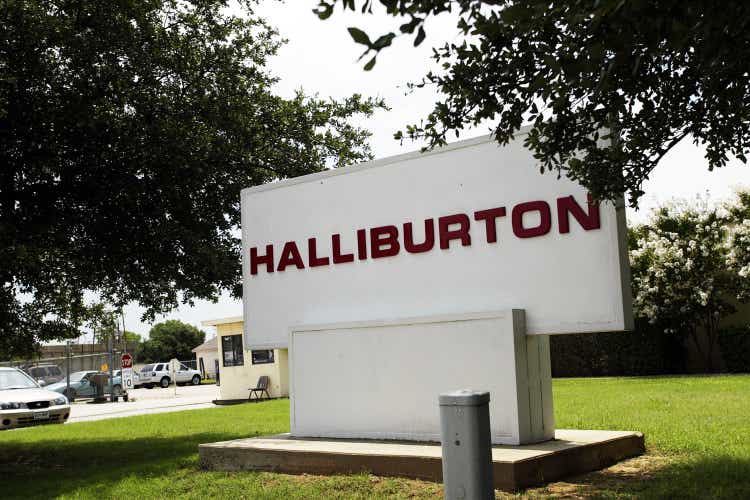Ronald Martinez
Investment thesis
The oil and gas industry is experiencing robust demand, evident from the growth of 2 million barrels per day in the first half of the year, compared to the same period last year. This highlights the continued essential role of oil and gas in the global economy.
Having in mind high oil prices in a foreseeable future, Halliburton (NYSE:HAL) is uniquely positioned to deliver financial outperformance. Rating is BUY.
Macro environment for the oil market and rig count
Since the start of June, we have made some updates to the forecasts for the oil market balance, given the following changes:
- OPEC reduced production in May 2023 by a smaller amount than we had expected.
- Saudi Arabia extended the 1 mbd production cut to August. (It had earlier planned to keep it only for July.)
- Russia is set to reduce oil exports by на 0.5 mbd in August. (We believe that goes for production as well.)
- The US plans to start selling 0.1 mbd of oil from its strategic inventory in September 2023.
- But we have made a more conservative projection for demand in third countries (excluding the US, China and the EU) in order to reflect the recessionary scenario to a fuller extent.
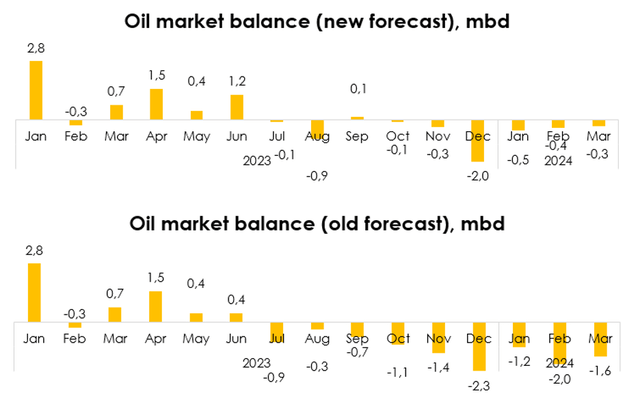
Invest Heroes
From now on through the end of the year, there will be a global shortage of oil, even with a recession in the EU and the US, due to the OPEC+ deal and voluntary cuts.
Because we have revised the oil market balance, we also have revised the outlook for Brent oil price in 2023 and now expect it to average $84.6/bbl in 2023. The key change from the previous outlook is that we believe the oil price has bottomed out.
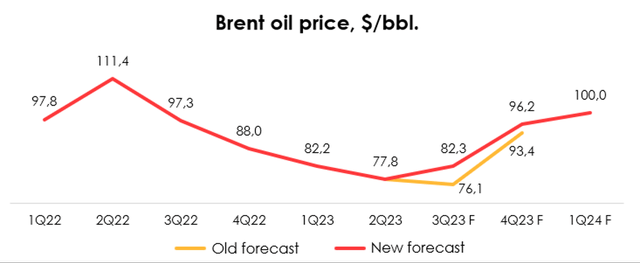
Invest Heroes
We do not expect oil prices to fall below $70 in the medium term, despite the recession (which we expect in the coming months), due to voluntary production cuts in Saudi Arabia and Russia (in July and August). We expect the Brent price to rise to $100.0/bbl by 4Q 2023 as the recession will be winding down and demand will increase faster than global oil production.
Previously, we projected the US and global rig count based on the assumption that the rig count would return to pre-COVID-19 levels. We have revised our forecast and now forecast US oil production on a quarterly basis.
According to the EIA, the US is in for a slight decline in oil production in 3Q 2023, which will be offset by steady subsequent growth that will bring output to 13 mbd by the end of 2024.
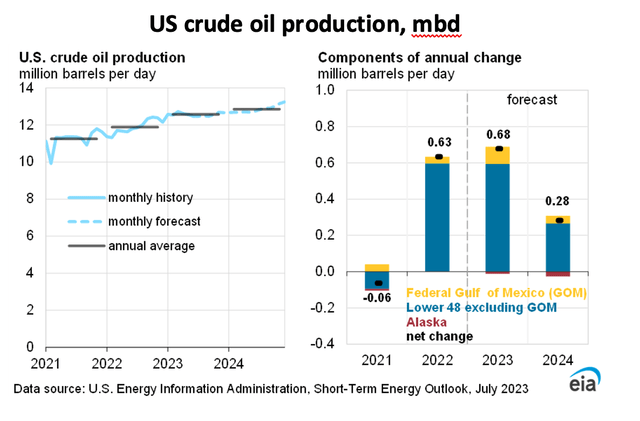
EIA
The rig count reflects the trend in US oil production. There’s a decline in the rig count forecast for 3Q 2023 and a gradual increase thereafter. According to our new forecast, we expect the US rig count to average 889 in 2023, down from the old forecast of 1015, and reach 1000 in 2024, down from the prior estimate of 1129.
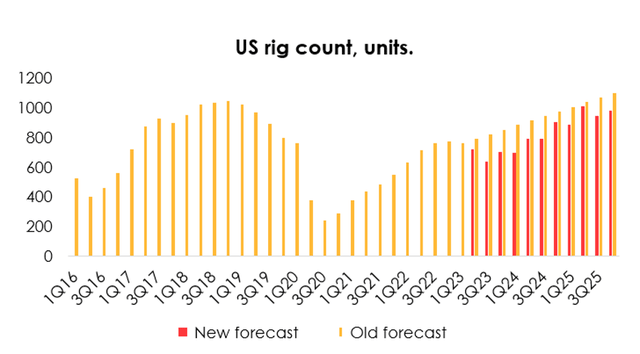
Invest Heroes
Financial Results
The company expects demand for its services to remain strong at current oil prices, and the market for high-performance equipment and quality services to remain tight, allowing the company to continue to increase the average revenue per rig.
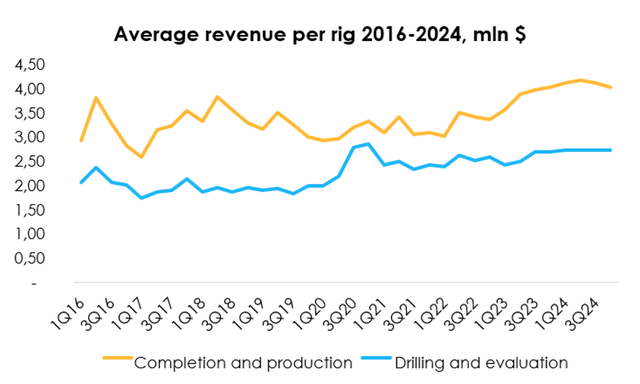
Invest Heroes
We have lowered the EBITDA forecast from $5149 mln (+29% y/y) to $5136 mln (+28.7% y/y) for 2023, and raised it from $5612 mln (+9% y/y) to $5656 mln (+10% y/y) for 2024. The reduction for 2023 was driven by a cut to the forecast for drilling rigs in North America from the average of 1015 to 889 for 2023. The increase for the 2024 EBITDA forecast was driven by the projection for a steady ramping up of the rig count, even though the earlier estimate for an average of 1129 rigs was lowered to 1000 rigs. The 2024 EBITDA outlook also got a boost from rising oil prices.
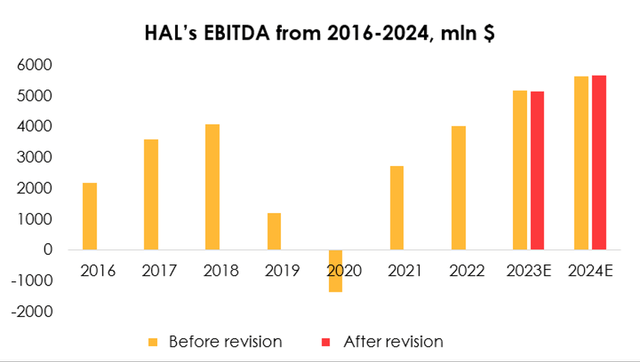
Invest Heroes
The company’s free cash flow is estimated to reach $2483 mln (+29% y/y) in 2023 and $2565 mln (+3% y/y) in 2024. FCF yield is set to be 7% and 8%, respectively.
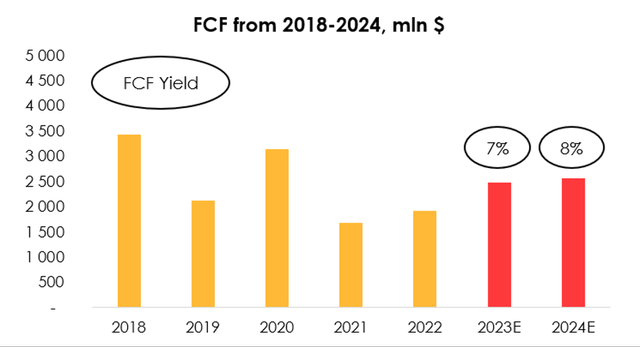
Invest Heroes
We expect the company’s net debt to fall from $5582 mln in 2022 to $4251 mln (-24% y/y) in 2023 and $1686 mln (-60% y/y) in 2024, assuming the company will direct all its cash toward paying off its debts. The net debt to EBITDA ratio is poised to come to 0.8х in 2023 and 0.3х in 2024, meaning the debt burden will become low.
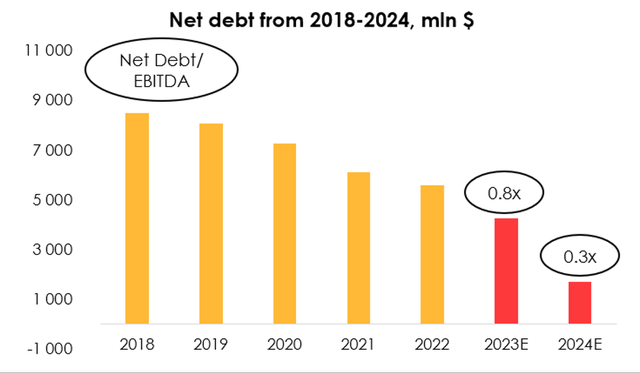
Invest Heroes
Valuation
The fair value price for the shares is $52.5. Rating is BUY. In our previous article we stated that the oilfield services sector to be one of the main beneficiaries of continued strong oil demand and crude shortages. As we see now HAL has increased its average check beyond our expectation. We stay bullish on stock.
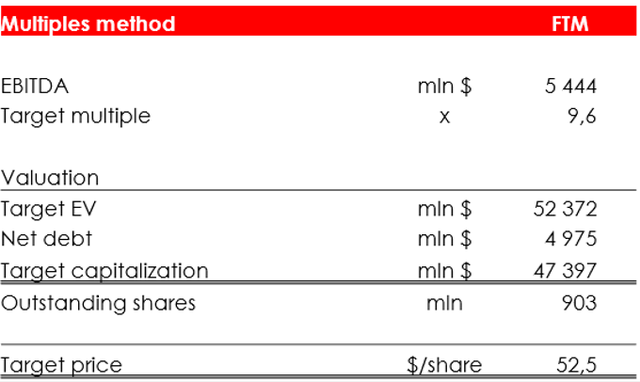
Invest Heroes
Risks
The main risk for the company is a more severe drop in demand for oil due to the upcoming recession. Consequently, the value of “black gold” shall fall substantially. More than 30% of global projects shall become unprofitable if prices fall below $ 60/bbl.
Conclusion
We still believe oil will start to be in short supply in the second half of the year, starting from July 2023, with the shortage reaching an average of 0.3 mbd in 3Q 2023. Higher oil prices will spur demand for drilling new wells, enabling the company to continue raising prices for its services.
According to our estimate, the upside over the next year is more than 40%, which we believe to be appealing for long-term investors. One shouldn’t forget that HAL’s shares are strongly tied to the performance of oil prices, while its financial results are exposed to oil indirectly. We believe that when the broader market drops sharply, HAL’s shares look like a promising bet on the recovery of global economy and the demand for oil.


